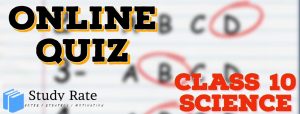Are you preparing for your Class 10 Science examinations? Do you find it challenging to tackle Assertion Reason questions? Well, fret not! In this comprehensive article, we will explore Class 10 Science Assertion Reason questions in the context. We will provide valuable insights and tips to help you excel in these types of questions. Additionally, we will also offer you the opportunity to download a PDF resource containing a collection of Assertion Reason questions specifically tailored for Class 10 Science. Let’s dive in!
Join our Telegram Channel, there you will get various e-books for CBSE 2024 Boards exams for Class 9th, 10th, 11th, and 12th.
Understanding the Structure of Assertion Reason Questions
In Assertion Reason questions, you are presented with an assertion statement, usually marked as “A,” and a reason statement, marked as “R.” Your task is to evaluate the relationship between these two statements and choose the correct option from the given choices, typically labeled as:
A. Both assertion and reason are true, and the reason is the correct explanation of the assertion. B. Both assertion and reason are true, but the reason is NOT the correct explanation of the assertion. C. Assertion is true, but the reason is false. D. Assertion is false, but the reason is true.
Table of Contents
Chapterwise Assertion Reason Questions for Class 10 Science
Assertion Reason questions are a popular format of examination questions that test your understanding, analytical skills, and logical reasoning. They require you to evaluate two statements: an assertion and a reason, and determine the relationship between them. These types of questions aim to assess your ability to critically analyze information and draw logical conclusions.
- Assertion and Reason Questions for Chapter 1 Chemical Reactions and Equations
- Assertion and Reason Questions for Chapter 2 Acids, Bases, and Salts
- Assertion and Reason Questions for Chapter 3 Metals and Non-metals
- Assertion and Reason Questions for Chapter 4 Carbon and Its Compounds
- Assertion and Reason Questions for Chapter 5 Periodic classification of elements
- Assertion and Reason Questions for Chapter 6 Life Processes
- Assertion and Reason Questions for Chapter 7 Control and Coordination
- Assertion and Reason Questions for Chapter 8 How do organisms reproduce?
- Assertion and Reason Questions for Chapter 9 Heredity and Evolution
- Assertion and Reason Questions for Chapter 10 Light Reflection and Refractions
- Assertion and Reason Questions for Chapter 11 The Human Eye and The Colorful World
- Assertion and Reason Questions for Chapter 12 Electricity
- Assertion and Reason Questions for Chapter 13 Magnetic effects of current
- Assertion and Reason Questions for Chapter 15 Our Environment
Tips for Approaching Assertion Reason Questions
Mastering Assertion Reason questions requires a strategic approach. Here are some tips to help you tackle these questions effectively:
- Carefully read the statements: Pay close attention to the assertion and reason statements. Understand their context and meaning before proceeding to evaluate their relationship.
- Analyze the statements independently: Evaluate the truthfulness of each statement individually before assessing their relationship. This step is crucial in making an informed decision.
- Focus on logical consistency: Determine if the reason statement provides a valid explanation for the assertion. Assess the logical consistency between the two statements to identify the correct option.
- Eliminate incorrect choices: If you are uncertain about the relationship between the statements, start by eliminating obviously incorrect choices. This strategy increases your chances of selecting the correct answer.
- Practice regularly: Regular practice is essential to enhance your ability to handle Assertion Reason questions. Familiarize yourself with different topics and question patterns to improve your accuracy and speed.
Common Mistakes to Avoid
While attempting Assertion Reason questions, it’s important to be aware of common mistakes students often make. Avoiding these errors can significantly improve your chances of answering correctly. Here are some mistakes to watch out for:
- Assuming the reason statement is always true: Don’t fall into the trap of assuming the reason statement is automatically true. Evaluate each statement independently to determine its accuracy.
- Ignoring keywords: Pay attention to keywords such as “always,” “sometimes,” or “never” in the statements. These words can impact the validity of the relationship between the assertion and reason.
- Neglecting to eliminate incorrect options: Don’t rush through the options without careful consideration. Eliminate clearly incorrect choices to narrow down your selection.
- Overthinking the statements: Sometimes, the relationship between the assertion and reason is straightforward. Avoid overanalyzing and unnecessarily complicating the question.
Subject-wise Approach to Assertion Reason Questions
To excel in Assertion Reason questions, it is helpful to understand the specific requirements and nuances of each subject. Let’s explore how to approach Assertion Reason questions in the subjects of Physics, Chemistry, and Biology.
Physics
In Physics, Assertion Reason questions often involve principles, laws, and concepts. It is crucial to have a strong understanding of the subject matter. Read the question carefully, identify the relevant concepts, and evaluate the relationship between the assertion and reason based on your knowledge of Physics.
Chemistry
Chemistry Assertion Reason questions generally pertain to chemical reactions, properties of substances, or theories. Analyze the given statements in light of your understanding of Chemistry principles. Look for cause-effect relationships and evaluate the accuracy of the reason statement in explaining the assertion.
Biology
Assertion Reason questions in Biology commonly revolve around biological processes, functions, and classifications. Develop a strong foundation in biological concepts and theories. Evaluate the given statements using your knowledge of Biology to identify the correct relationship between the assertion and reason.
Importance of Practicing Assertion Reason Questions
Regular practice of Assertion Reason questions is essential for several reasons. Firstly, it enhances your critical thinking and logical reasoning abilities. Secondly, it familiarizes you with the different question patterns and topics that frequently appear in examinations. Lastly, practicing these questions improves your time management skills, allowing you to answer them efficiently during the actual examination.
Conclusion
Mastering Assertion Reason questions is a valuable skill that will greatly benefit your performance in Class 10 Science examinations. By understanding the structure, applying effective strategies, and practicing regularly, you can confidently approach these questions and improve your scores. Remember to stay calm, focus on logical consistency, and carefully evaluate each statement before making your selection.
FAQs on CBSE Class 10 Science Assertion Reason Questions
Where can I find Assertion Reason questions for Class 10 Science?
You can download a comprehensive PDF resource containing Class 10 Science Assertion Reason questions from schools.studyrate.in. This resource is designed to help you practice and excel in these types of questions.
How can Assertion Reason questions benefit my exam preparation?
Practicing Assertion Reason questions enhances your ability to analyze information, draw logical conclusions, and manage your time effectively during examinations. These skills contribute to improved overall performance.
Why are Assertion Reason questions important?
Assertion Reason questions test your critical thinking, analytical skills, and logical reasoning abilities. Regular practice of these questions enhances your overall understanding and improves your performance in examinations.


